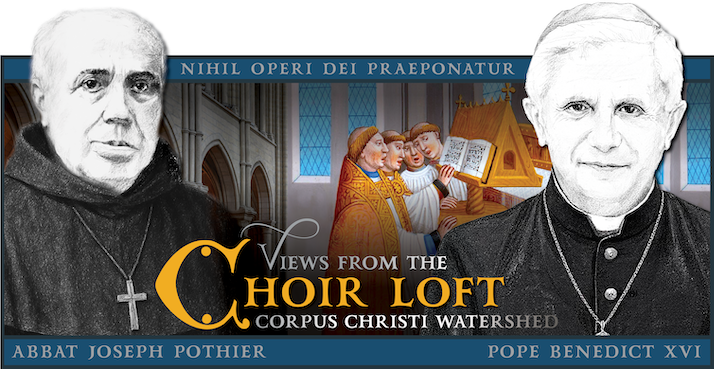 ANY SAINTS DO NOT have their own propers. Instead, one must utilize the COMMUNE SANCTORUM. Suppose someone asked you: “When it comes to the COMMUNE SANCTORUM, where can I find organ accompaniments matching the rhythm of the Liber Usualis?” You might respond: “Tons of organ accompaniments have been published by composers who follow the Liber Usualis rhythm. Henri Potiron, Dom Desrocquettes, Abbé Ferdinand Portier, Monsignor Manzetti, Feliks Raczkowski, Auguste Le Guennant, Father Carlo Rossini, Euphemia Bank, Dr. Theodore Marier, Father Andrew Green, Father Percy Jones, and Achille P. Bragers are examples of such composers. I’m sure many of them wrote accompaniments for the COMMUNE SANCTORUM.” However, this is not true!
ANY SAINTS DO NOT have their own propers. Instead, one must utilize the COMMUNE SANCTORUM. Suppose someone asked you: “When it comes to the COMMUNE SANCTORUM, where can I find organ accompaniments matching the rhythm of the Liber Usualis?” You might respond: “Tons of organ accompaniments have been published by composers who follow the Liber Usualis rhythm. Henri Potiron, Dom Desrocquettes, Abbé Ferdinand Portier, Monsignor Manzetti, Feliks Raczkowski, Auguste Le Guennant, Father Carlo Rossini, Euphemia Bank, Dr. Theodore Marier, Father Andrew Green, Father Percy Jones, and Achille P. Bragers are examples of such composers. I’m sure many of them wrote accompaniments for the COMMUNE SANCTORUM.” However, this is not true!
Extremely Rare Book • As a matter of fact, only one composer has ever published a COMMUNE SANCTORUM accompaniment which matches the rhythm of the Liber Usualis. I speak of Maestro Julius Bas, who was commissioned by the Abbey of Solesmes (circa 1910) to compose harmonizations for the complete KYRIALE, GRADUALE, and ANTIPHONALE. Some say Julius Bas was a member of the famous Vatican Commission on Gregorian Chant established by Pope Pius X. Dom Pierre Combe’s book waffles back and forth regarding whether he was an official member (cf. pp. 275, 284-285).1 I personally do not believe Bas was a member, because BAS’ BIOGRAPHY would have mentioned this. Getting back to the COMMUNE SANCTORUM, we have scanned and uploaded this extremely rare book:
* PDF Download • “COMMUNE SANCTORUM” (Julius Bas)
—Published in 1910 • 165 pages • 75.9MB • Commune sanctorum ad exemplar editionis vaticanae concinnatum cui accedunt: Missa votiva de beata, Missa de immaculata conceptione, Missa de Spiritu Sancto, Missa pro pace; Cantum Gregorianum transcripsit et modulationibus ornavit Julius Bas ad normam editionis rythmicae a solesmensibus monachis exaratae.
![]()
![]()
More on Bas • With regard to Julius Bas, many of his accompaniments can be downloaded from the LALANDE LIBRARY. You can download his 1923 Treatise on Gregorian Chant Accompaniment (which includes an interesting appendix on fugue subjects and tonal answers) in French or in German.
Fabulous Discovery! • While researching Julius Bas, I noticed he was chosen to provide the Gregorian accompaniments for a fascinating Roman Catholic hymnal published in 1915 by Father Sidney Sykes Hurlbut (1858-1920), pastor at Saint Mary’s Parish Church in Hagerstown. The book has a 1915 IMPRIMATUR from the Archbishop of Baltimore.
* PDF Download • FATHER SIDNEY HURLBUT’S HYMNAL (1915)
—Official Title: A Treasury of Catholic Song • 312 pages.
Wonderful Content • Without question, Father Hurlbut’s tome is the most impressive of all Catholic hymnals published in America (during that time period). No other American hymnal came close to matching its quality until the 1970s, when Dr. Theodore Marier published “Hymns, Psalms, and Spiritual Canticles.” I feel comfortable making such an assertion because I’ve spent decades examining Catholic hymn books from that era. Many of the hymns contained in Father Hurlbut’s collection are also found in the Brébeuf Catholic Hymnal, such as: Splendor paternae gloriae; Aeterna coeli gloria; En clara vox redarguit; Jesu Redemptor omnium; A solis ortus cardine; Corde natus es parentis; Crudelis Herodes Deum; Audi benigne Conditor; O Sol salutis intimis; Vexilla Regis prodeunt; Ad regias Agni dapes; Aurora coelum purpurat; Anima Christi; O Esca viatorum; Qui procedis ab utroque; Ave vivens Hostia; Ave maris stella; Auctor beate saeculi; Quicumque certum quaeritis; Placare Christe servulis; Adoro te devote; and Salve caput cruentatum. Many of the excellent hymn tunes are also found in the Brébeuf—e.g. MELCOMBE, TOULON, WHITEHEAD, and ST VENANTIUS.
Surprising Content • I was amazed to see Catholic hymns included by Father Hurlbut which were not included in the Brébeuf Catholic Hymnal. Examples would be: Tandem fluctus tandem luctus; Jure plaudant omnia; Parvum quando cerno Deum; Linquunt tecta magi principis urbis; Jesu thronum majestatis; Solemne nos jejunii; Jesu nostros ob reatos; Salvete Christi vulnera; Cor meum tibi dedo; Petri laudes exsequamur; Saevo dolorum turbine; Praeclara custos virginum; Ubi thesaurus ibi cor; Supreme Rector coelitum; and Ave sacer Christi sanguis. Shown below are examples of the Gregorian accompaniments Julius Bas contributed to Father Hurlbut’s hymnal:
![]()

1 This article includes excerpts from: HISTOIRE DE LA RESTAURATION DU CHANT GRÉGORIEN D’APRES DES DOCUMENTS INEDITES: SOLESMES ET L’EDITION VATICANE published in 1969 by Dom Pierre Combe of Solesmes Abbey. The Catholic University Press published an English edition in 2003, translated by Dr. Theodore Marier and finished by a former student of his (since Dr. Marier had died before the work could be completed). Someone close to Dr. Marier told me that Marier found the work of translation tedious, and would often exclaim: “Well, I guess I’d better go subtract a few years off my time in Purgatory by translating Combe!” The 2003 version is called: “The Restoration of Gregorian Chant: Solesmes and the Vatican Edition.” Broadly speaking, the 1969 book by Dom Combe is a collection of journal articles. Many of the Italian sections in the 2003 version were translated by Monsignor Robert Skeris.
![]()






